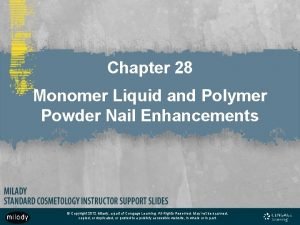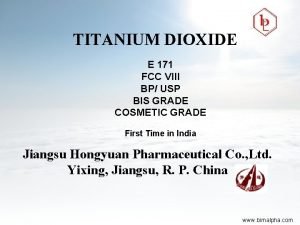Doped Poly Methyl Methacrylate and Titanium Dioxide Nanoparticle

- Slides: 1

Doped Poly Methyl Methacrylate and Titanium Dioxide Nanoparticle Linear Optical Properties of Organic Dye Bashair S. Mahdi 1, Abdulazeez O. Mousa 2, Ali Jassim Al-zuhairi 3 Department of Human Healthy , Collage of Food Science, Al-Qasim Green University 1 Department of Physics, College of Science , University of Babylon 2 Department of Energy, College of Engineering- Al-Musayab , University of Babylon 3 Abstract Discussion The spectral properties (absorption and fluorescence) of laser dyes for Aurintricarboxylic Acid compound (s) have been studied dissolved in Dimethyl sulfoxide (DMSO) prepare(10 -4 and 10 -5) at room temperature. The achieved results pointed out to an increase in the absorption intensities with the increased concentration which are found in agreement with Beer – Lambert law, these results have been also showed an expansion in the spectral range of absorption and fluorescence with a shift in the direction of short wavelength with high energy, the quantum efficiency of the dissolved compound (s) in Dimethyl sulfoxide DMSO has been calculated by using thin film for pure dye and use polymer (PMMA) with dye and use Titanium dioxide nanoparticle with dye and polymer with thickness (100, 120 and 140) nm respectively, radiative lifetime for thin film with dye add polymer and nanoparticle become less when we compare with pure dye also quantum efficiency increase when we use polymer and nanoparticle, thus we can use this material as laser active media Introduction Nanostructure materials are a new type of materials that exhibit unique features and properties in different fields Synthesis of nanoparticles in matrixes such as polymer films are of major interest in several optical, nonlinear optical, and sensor applications. Organic dye doped polymers have a great deal of concern in last years due to their great potential in many important applications such as optical storage, optical switching, optical limiting, signal processing, holography and nonlinear optical devices processing, and nonlinear optical devices as well as various kinds of photonic devices. In a solid-state dye laser the organic dye molecules are uniformly distributed in a highly homogenous matrix there a number of materials which have been used as solid hosts for laser dyes such as polymers , glasses , organically modified silicates or nano-composites. An example of such polymer highly pure form poly methyl methacrylate (PMMA). In general , the solid host materials suitable in solid-state dyes laser. They should be highly transparent to the pump laser and dye laser wavelengths. Polymeric matrices have some important advantages over other host materials because they are simple to prepare and cheap to produce. When light interacts with matter the optical processes observed in solid state materials can be classified as reflection, absorption, and transmission. The intensity I O of the beam incident to the surface of the solid medium must equal the sum of the intensities of the transmitted, absorbed, and reflected beams, denoted as I T, IA, and I R respectively. IO = I T + I A + I R (1) Where: IO: total intensity , IT: transmission intensity , IA: absorption intensity , and IR: reflective intensity T+A+R=1 (2) Where T: transmission , A: absorption, and R: reflective A number of parameters can be used to quantify the optical properties of materials. In particular the refractive index, or refractivity, absorption coefficient, or absorbance, are defined as the ratio of refracted to incident intensity and absorbed to incident intensity respectively. Contact <your name> Bashair S. Mahdi <your organization>university of Al. Qasim Green University References 1. 2. 3. 4. Characteristic of the crystal structure using x-ray diffraction (XRD) of the Aurintricarboxylic Acid compound (s) , distance between planers(d), Full Width at Half Maximum (FWHM), and crystalline size (G)are shown in Tables. 2θ (deg) sin(θ) (d) nm FWHM (β) (rad) (G) nm 24 0. 2078 0. 371 0. 205 39. 508 3 0. 0262 2. 946 0. 247 32. 163 The change in the wavelength of absorption and fluorescence to obtain stock shift (nm) , we can note the quantum efficiency increase when add polymer and Ti. O 2 nanoparticle because when we add polymer or nanoparticle thickness of thin film will increase and that led to make molecular of (DMSO) system to move freely in the new host material but thin film with less volume restricted molecular moving and led to consist dimmers and aggregation which have perfect properties. In this experimental work we have investigated the effects of dye concentration on the optical properties of pure dye , dye doped PMMA, and dye with PMMA pulse Ti. O 2 prepare as thin films. Using transmittance and absorption spectrum, linear absorption coefficient(α 0) , linear refractive index(n 0), lifetime fluoresce(Ʈƒ), lifetime radiative (Ʈƒm) led to enhance the optical properties of PMMA and Ti. O 2 nanoparticle by increase refractive index with quantum yield and reduce lifetime radiative according to increase thickness of thin film by adding host material to give the molecular of dye more space moving to get films consider a promised materials as active laser media as well as we can use this material in photo device. Wave length of absorption and fluorescence peaks, stock shift and the quantum efficiency of compound (s). Material Compound (s) pure C mole/litter 10 -4 10 -5 Compound (s) +PMMA+Nano 10 -4 10 -5 λabsλ (nm) λfluo (nm) Stock Shift (nm) 274 275 287 263 292 287 285 283 288 287 294 293 11 8 1 24 2 6 Quantum Efficiency qfm 53% 56% 45% 98% 57% 59% A. Hussien. Al-kaissy, "Nonlinear Optical Properties Epoxy/Alumina Nanocomposites " , ph. d thesis, University of Baghdad Institute of Laser for Postgraduate Studies, (2011). G. B. Heising and W. M. Lauer, "Ammonium Salt of Aurin Tricarboxylic Acid ", Journal of Organic Syntheses, Vol. 1, (1929). Y. Andy, H. Fuh, L. Chi, S. Ting, and H. Ching, "Nonlinear Optical Properties of Azo-Dye Doped Liquid Crystals Determined by Biphotonic z-scan Technique", Journal of optical express, Vol. 81. (2005). L. David and B. Moldovan, " Green Synthesis of Biogenic Silver Nanoparticles for Efficient Catalytic Removal of Harmful Organic Dyes", Journal of Nanomaterials , Vol. 202, (2020).

